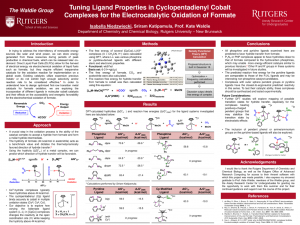Niedzwiecki, Isabella: Tuning Ligand Properties in Cyclopentadienyl Cobalt Complexes for the Electrocatalytic Oxidation of Formate
Title: Tuning Ligand Properties in Cyclopentadienyl Cobalt Complexes for the Electrocatalytic Oxidation of Formate
Name: Isabella Niedzwiecki
Major: Chemistry
School affiliation: School of Arts and Sciences
Programs: Aresty Summer Science Program
Other contributors: Kate Waldie and Sriram Katipamula
Abstract: For the application of fuel cell technology on a global scale, efficient catalysts based on inexpensive and abundant first-row transition metals are needed to optimize the oxidation of chemical fuels. By harvesting electrical energy directly through electrochemical oxidation, fuel cells may provide a more sustainable means of energy production at higher theoretical efficiencies than combustion. For the oxidation of formate, a reduced carbon fuel, existing catalysts do not exhibit high enough selectivity and/or reaction rate to be considered effective. Therefore, we are exploring the incorporation of different ligands in transition metal complexes and their effects on the accessibility and energetic favorability of the oxidation reaction to determine the key requirements for optimal catalyst design. Using density functional theory (DFT) calculations, the free energy of several [CpCo(L-L)X]n+ complexes (X = CH3CN, H−) were calculated, where Cp was the cyclopentadienyl ligand and L-L was various phosphine or pyridine-derived ligand systems with different steric and electronic properties. The free energies of each acetonitrile and hydride complex were then used to calculate the free energy of reaction for hydride transfer from formate to cobalt, a key step in the proposed mechanism for electrochemical formate oxidation. While all the proposed complexes displayed thermodynamically favored hydride transfer from formate, some trends in the reaction free energy values for each ligand system could be gleaned. Further proposals for ligand structures are presented that include pendent cationic groups or hydrogen bond donors to increase the rate of hydride transfer by electrostatic or hydrogen bonding interactions.
